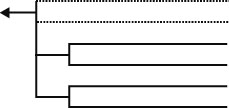| NIES-MCC | KU-MACC | Tree to Strain | Japanese | English |
| Life / Eukarya / Excavata / Discicristata / Euglenozoa / Euglenophyceae | |

|
Sphenomonadales (Petalomonas, Sphenomonas etc.) |
|
* Dotted lines indicate they may be polyphyletic |
|
| References |
|
|
The euglenophyceans (euglenids, euglenoids) are basically unicellular flagellate. In the Euglenophyceae, a photosynthetic genus, Euglena is well known, but there are many colorless phagotrophic or osmotrophic species in the class. The green chloroplast of Euglena is originated via secondary endosymbiosis with a green plant at the common ancestor of the Eutreptiales and Euglenales. Euglena gracilis is widely used for laboratory. The cell is usually naked, but some species such as Trachelomonas (Euglenales) possess lorica deposited by iron and magnesium. The most unique feature of the Euglenophyceae is the presence of proteinaceous strips, pelicler strips beneath the cell membrane. The species with many flexible pellicler strips (e.g. Euglena, Peranema) show metaboly (euglenoid movement). However, species with a few rigid pellicler strips (e.g. Petalomonas, Phacus) show no metaboly. Phagotrophic euglenoids usually possess complex cytostome supported by microtubules. Reserve polysaccharide is β-1,3 glucan (paramyron) in cytosol except for early divergences. Paramyron is sometimes used commercially. The chloroplast is surrounded by three membranes, and possesses chlorophylls a and b. Photosynthetic (and secondarily heterotrophic) species possess the stigma at the side wall of anterior depression. In these species, the photoreceptor apparatus, paraflagellar body is present at the flagellar base. |
 1: Eutreptiella (Eutreptiales, NIES-381). 2: Petalomonas (Sphenomonadales). 3: Euglena (Euglenales). 4: Ploeotia (Heteronematales). 5: Phacus (Euglenales). |